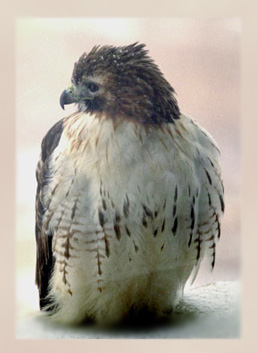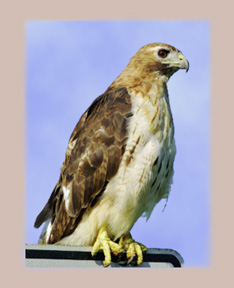Leon M. Lederman
Science Education Center
Fermilab Flora and Fauna Virtual exhibit
Red-tailed Hawk
Prairie Resources - Exhibits Home Page The Red-tailed hawk is Fermilab's
most common raptor. It is a year-round resident and summer breeder.
Up to eight pairs have nested on the lab grounds in one year,
and up to 30 birds have been recorded in a single winter day.
The Red-tailed hawk is Fermilab's
most common raptor. It is a year-round resident and summer breeder.
Up to eight pairs have nested on the lab grounds in one year,
and up to 30 birds have been recorded in a single winter day.
Red-tailed hawks are birds of prey, or raptor. Like falcons and other hawks, they have strong feet, razor-sharp claws, or talons, and a hooked bill. The birds use these body parts like weapons to strike, stab, and rip prey. They kill not for fun or sport, but to survive. Mature birds of prey are at the top of their food chain and have few natural predators. Their main enemies are pollution and loss of habitat.
The Red-tail belongs to a group of hawks called buteos, whose members have broad wings and short tails. They are fairly easy to see because they spend much of their time soaring and perching in open areas. The major identifying factor is its red tail. If you are lucky, you may see one sitting on the ledge outside the east window on the 15th floor of Wilson Hall - one of their favorite perches!
Hawks start their day by stretching, casting pellets, defecating, and preening their feathers. Soon they leave the roost or nest site and begin to hunt. Most hawks eat just about any animal, such as small mammals, birds, and snakes. The buteos tend to swoop down upon their prey which they kill with their talons. At the end of the day the red-tail returns to its roost, usually a favorite tree, cliff or other elevated perch.
A pair of breeding hawks builds a large stick nest on a rock ledge or a sturdy tree branch. The female incubates two to four eggs for about one month. After the young hatch the male provides most of the food while the female cares for the chicks at the nest. By fall, the young birds are as large as their parents, but duller in color. They are fully mature and ready to breed by their second year.
 Birds of prey have
extremely sharp sight, up to eight times sharper than our eyesight.
Hawks have an overlapping field of view of 30-50 degrees for binocular
vision, and an overall field of view of about 150 degrees. The
field of view of the two eyes - the area that each one can see
- over-lap, so the brain receives two different sets of messages
about the same part of the picture. This allows the bird's brain
to work out distance and speed, which is very important for catching
prey.
Birds of prey have
extremely sharp sight, up to eight times sharper than our eyesight.
Hawks have an overlapping field of view of 30-50 degrees for binocular
vision, and an overall field of view of about 150 degrees. The
field of view of the two eyes - the area that each one can see
- over-lap, so the brain receives two different sets of messages
about the same part of the picture. This allows the bird's brain
to work out distance and speed, which is very important for catching
prey.
Raptors need to eat large quantities of food for their size because as much as 30% of their food may be made up of indigestible feathers, fur, or bones. This indigestible material is regurgitated sometime after the meal in the form of a pellet. The contents of the pellets may vary at different times of the year, depending upon what prey is available.
The feet are very powerful. Hawks have three toes pointing forward and one pointing backwards. The inside toe and the hind toe are usually stronger than the others, with larger claws. These toes are used to grip the prey, while the middle and outer toes are used to balance the foot when it is walking or perching. The claws can also be used to kill prey by piercing a weak spot, or by crushing it.
Watch carefully as you walk or drive through Fermilab and you may see a Red-tailed hawk perched on a street light, road sign, or tree branch, or soaring gracefully through the air.
Sources
Baily, Jill. Birds of Prey ; Burmie, David. Bird ; Dewitt, Lynda. Eagles, Hawks, and Other Birds of Prey ; Peter Kasper, The Birds of Fermilab; Willowbrook Wildlife Center
 Top
of page
Top
of page